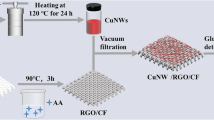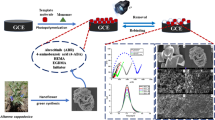Abstract
An electrochemiluminescence (ECL) aptasensor for the detection of the milk protein allergen β-lactoglobulin (β-LG) using nanocomposite as luminophore was fabricated. The Ru-AuNPs/GNP/Naf complex was formed by combining the Rubpy32+-AuNPs complex (Ru-AuNPs), prepared by modifying the negatively charged surface of gold nanoparticles (AuNPs) with positively charged Rubpy32+ through electrostatic interactions and the graphene nanoplatelets-Nafion (GNP/Naf) at a ratio of 2:1. The nanocomposite was coated on the surface of the screen-printed electrode (SPCE) through the film-forming properties of Nafion. A layer of chitosan (CS) was coated onto this modified electrode, and later amine-terminated β-LG aptamers were covalently attached to the CS/Ru-AuNP/GNP/Naf via glutaraldehyde (GLUT) cross-linking. When β-LG was incubated with the aptasensor, a subsequent decrease in ECL intensity was recorded. Under the optimal conditions, the ECL intensity of the aptasensor changed linearly with the logarithmic concentration of β-LG, in the range 0.1 to 1000 pg/ml, and the detection limit was 0.02 pg/mL (3σ/m). The constructed aptasensor displayed simple and fast determination of β-LG with excellent reproducibility, stability, and high specificity. Additionally, the proposed ECL aptasensor displayed high recoveries (92.5–112%) and low coefficients of variation (1.6–7.8%), when β-LG fortified samples were analyzed. Integrating Ru-AuNPs/GNP/Naf nanocomposite in the ECL aptasensor paves the way towards a cost-effective and sensitive detection of the milk allergen β-LG.
Graphical abstract










Similar content being viewed by others
References
Tordesillas L, Berin MC, Sampson HA (2017) Immunology of food allergy. Immunity 47:32–50. https://doi.org/10.1016/j.immuni.2017.07.004
Amor-Gutiérrez O, Selvolini G, Fernández-Abedul MT et al (2020) Folding-based electrochemical aptasensor for the determination of β-lactoglobulin on poly-L-lysine modified graphite electrodes. Sensors 20:2349. https://doi.org/10.3390/s20082349
Nehra M, Lettieri M, Dilbaghi N et al (2019) Nano-biosensing platforms for detection of cow’s milk allergens: an overview. Sensors 20:32. https://doi.org/10.3390/s20010032
He S, Li X, Wu Y et al (2018) Highly sensitive detection of bovine β-lactoglobulin with wide linear dynamic range based on platinum nanoparticles probe. J Agric Food Chem 66:11830–11838. https://doi.org/10.1021/acs.jafc.8b04086
Ivens KO, Baumert JL, Taylor SL (2016) Commercial milk enzyme-linked immunosorbent assay (ELISA) kit reactivities to purified milk proteins and milk-derived ingredients. J Food Sci 81:T1871–T1878. https://doi.org/10.1111/1750-3841.13357
Galan-Malo P, Pellicer S, Pérez MD et al (2019) Development of a novel duplex lateral flow test for simultaneous detection of casein and β-lactoglobulin in food. Food Chem 293:41–48. https://doi.org/10.1016/j.foodchem.2019.04.039
Xiao-yu K, Jing W, Yan-jun T, et al (2012) HPLC analysis of α-lactalbumin and β-lactoglobulin in bovine milk with C4 and C18 column. J Northeast Agric Univ (English Ed 19:76–82. https://doi.org/10.1016/S1006-8104(13)60026-4
Czerwenka C, Műller L, Lindner W (2010) Detection of the adulteration of water buffalo milk and mozzarella with cow’s milk by liquid chromatography–mass spectrometry analysis of β-lactoglobulin variants. Food Chem 122:901–908. https://doi.org/10.1016/j.foodchem.2010.03.034
Billakanti JM, Fee CJ, Lane FR et al (2010) Simultaneous, quantitative detection of five whey proteins in multiple samples by surface plasmon resonance. Int Dairy J 20:96–105. https://doi.org/10.1016/j.idairyj.2009.08.008
Nowak-Wegrzyn A, Bloom KA, Sicherer SH et al (2008) Tolerance to extensively heated milk in children with cow’s milk allergy. J Allergy Clin Immunol 122:342-347.e2. https://doi.org/10.1016/j.jaci.2008.05.043
Matassan ND, Rizwan M, Mohd-Naim NF, et al (2018) Graphene nanoplatelets-based aptamer biochip for the detection of lipocalin-2. In: 2018 IEEE SENSORS. IEEE, 1–4
Zhai Q, Li J, Wang E (2017) Recent advances based on nanomaterials as electrochemiluminescence probes for the fabrication of sensors. ChemElectroChem 4:1639–1650. https://doi.org/10.1002/celc.201600898
Li Y, Qi H, Gao Q, Zhang C (2011) Label-free and sensitive electrogenerated chemiluminescence aptasensor for the determination of lysozyme. Biosens Bioelectron 26:2733–2736. https://doi.org/10.1016/j.bios.2010.09.048
Bozorgzadeh S, Haghighi B, Gorton L (2015) Fabrication of a highly efficient solid state electrochemiluminescence sensor using Ru(bpy)32+ incorporated nanoZnO-MWCNTs-Nafion composite film. Electrochim Acta 164:211–217. https://doi.org/10.1016/j.electacta.2015.02.188
Moretto LM, Kohls T, Badocco D et al (2010) Electrochemiluminescence of loaded in Nafion Langmuir-Blodgett films: role of the interfacial ultrathin film. J Electroanal Chem 640:35–41. https://doi.org/10.1016/j.jelechem.2009.12.029
Bao L, Sun L, Zhang Z-L et al (2011) Energy-level-related response of cathodic electrogenerated-chemiluminescence of self-assembled CdSe/ZnS quantum dot films. J Phys Chem C 115:18822–18828. https://doi.org/10.1021/jp205419z
Zou X, Shang F, Wang S (2017) Electrochemical luminescence determination of hyperin using a sol-gel@graphene luminescent composite film modified electrode for solid phase microextraction. Spectrochim Acta Part A Mol Biomol Spectrosc 173:843–848. https://doi.org/10.1016/j.saa.2016.10.037
Chen C, Wei G, Yao X et al (2018) Ru(bpy)32+/β-cyclodextrin-Au nanoparticles/nanographene functionalized nanocomposites-based thrombin electrochemiluminescence aptasensor. J Solid State Electrochem 22:2059–2066. https://doi.org/10.1007/s10008-018-3910-6
Raju CV, Sornambigai M, Kumar SS (2020) Unraveling the reaction mechanism of co-reactant free in-situ cathodic solid state ECL of Ru(bpy)32+ molecule immobilized on Nafion coated nanoporous gold electrode. Electrochim Acta 358:136920. https://doi.org/10.1016/j.electacta.2020.136920
Noor Azam NF, Mohd-Naim NF, Kurup CP, Ahmed MU (2020) Electrochemiluminescence immunosensor for tropomyosin using carbon nanohorns/Nafion/Fe3O4@Pd screen-printed electrodes. Microchim Acta 187:456. https://doi.org/10.1007/s00604-020-04440-2
Wei H, Wang E (2011) Electrochemiluminescence of tris(2,2′-bipyridyl)ruthenium and its applications in bioanalysis: a review. Luminescence 26:77–85. https://doi.org/10.1002/bio.1279
Mao L, Yuan R, Chai Y et al (2010) Multi-walled carbon nanotubes and Ru(bpy)32+/nano-Au nano-sphere as efficient matrixes for a novel solid-state electrochemiluminescence sensor. Talanta 80:1692–1697. https://doi.org/10.1016/j.talanta.2009.10.008
Liu X, Zhang J, Yan R et al (2014) Preparation of graphene nanoplatelet–titanate nanotube composite and its advantages over the two single components as biosensor immobilization materials. Biosens Bioelectron 51:76–81. https://doi.org/10.1016/j.bios.2013.07.029
Noor Azam NF, Mohammad NA, Lim SA, Ahmed MU (2019) A label-free cardiac troponin T electrochemiluminescence immunosensor enhanced by graphene nanoplatelets. Anal Sci Int J Japan Soc Anal Chem 35:973–978. https://doi.org/10.2116/analsci.19P105
Rizwan M, Mohd-Naim NF, Keasberry NA, Ahmed MU (2017) A highly sensitive and label-free electrochemiluminescence immunosensor for beta 2-microglobulin. Anal Methods 9:2570–2577. https://doi.org/10.1039/c7ay00263g
Huang B, Yao C, Zhang Y, Lu X (2020) A novel label-free solid-state electrochemiluminescence sensor based on the resonance energy transfer from Ru(bpy)32+ to GO for DNA hybridization detection. Talanta 218:121126. https://doi.org/10.1016/j.talanta.2020.121126
Ke H, Zhang X, Guo W et al (2017) A MWCNTs-Pt nanohybrids-based highly sensitive electrochemiluminescence sensor for flavonoids assay. Talanta 171:1–7. https://doi.org/10.1016/j.talanta.2017.04.045
Cao N, Zeng P, Zhao F, Zeng B (2019) Au@SiO2@RuDS nanocomposite based plasmon-enhanced electrochemiluminescence sensor for the highly sensitive detection of glutathione. Talanta 204:402–408. https://doi.org/10.1016/j.talanta.2019.06.030
Sun X, Du Y, Dong S, Wang E (2005) Method for effective immobilization of Ru(bpy)32+ on an electrode surface for solid-state electrochemiluminescene detection. Anal Chem 77:8166–8169. https://doi.org/10.1021/ac051476+
Dong M, Li M, Qi H et al (2015) Electrogenerated chemiluminescence peptide-based biosensing method for cardiac troponin I using peptide-integrating Ru(bpy)3 2+-functionalized gold nanoparticles as nanoprobe. Gold Bull 48:21–29. https://doi.org/10.1007/s13404-015-0156-2
Eissa S, Zourob M (2017) In vitro selection of DNA aptamers targeting β-lactoglobulin and their integration in graphene-based biosensor for the detection of milk allergen. Biosens Bioelectron 91:169–174. https://doi.org/10.1016/j.bios.2016.12.020
Kurup CP, Mohd-Naim NF, Tlili C, Ahmed MU (2021) A highly sensitive label-free aptasensor based on gold nanourchins and carbon nanohorns for the detection of lipocalin-2 (LCN-2). Anal Sci 37:825–831. https://doi.org/10.2116/analsci.20P303
Tah A, Olmos Cordero JM, Weng X, Neethirajan S (2018) Aptamer-based biosensor for food allergen determination using graphene oxide/gold nanocomposite on a paper-assisted analytical device. bioRxiv 343368. https://doi.org/10.1101/343368
Gao J, Chen Z, Mao L et al (2019) Electrochemiluminescent aptasensor based on resonance energy transfer system between CdTe quantum dots and cyanine dyes for the sensitive detection of ochratoxin A. Talanta 199:178–183. https://doi.org/10.1016/j.talanta.2019.02.044
Lettieri M, Hosu O, Adumitrachioaie A et al (2020) Beta-lactoglobulin electrochemical detection based with an innovative platform based on composite polymer. Electroanalysis 32:217–225. https://doi.org/10.1002/elan.201900318
Shi M, Cen Y, Sohail M et al (2018) Aptamer based fluorometric β-lactoglobulin assay based on the use of magnetic nanoparticles and carbon dots. Microchim Acta 185:40. https://doi.org/10.1007/s00604-017-2569-5
Clemente APB, Kuang H, Shabana AM et al (2019) Design of an aptamer-amphiphile for the detection of β-lactoglobulin on a liquid crystal interface. Bioconjug Chem 30:2763–2770. https://doi.org/10.1021/acs.bioconjchem.9b00412
Jia M, Jia B, Liao X et al (2022) A CdSe@CdS quantum dots based electrochemiluminescence aptasensor for sensitive detection of ochratoxin A. Chemosphere 287:131994. https://doi.org/10.1016/j.chemosphere.2021.131994
Gao H, Wang X, Li M et al (2017) Proximity hybridization-regulated electrogenerated chemiluminescence bioassay of α-fetoprotein via target-induced quenching mechanism. Biosens Bioelectron 98:62–67. https://doi.org/10.1016/j.bios.2017.06.042
Hernandez-Aldave S, Tarat A, McGettrick JD, Bertoncello P (2019) Voltammetric detection of caffeine in beverages at Nafion/graphite nanoplatelets layer-by-layer films. Nanomaterials 9:221. https://doi.org/10.3390/nano9020221
Suroviec AH (2012) Determining surface coverage of self-assembled monolayers on gold electrodes. Chem Educ 17(3):83–85. https://doi.org/10.1333/s00897122424a
Qi H, Li M, Dong M et al (2014) Electrogenerated chemiluminescence peptide-based biosensor for the determination of prostate-specific antigen based on target-induced cleavage of peptide. Anal Chem 86:1372–1379. https://doi.org/10.1021/ac402991r
Guo Z, Dong S (2004) Electrogenerated chemiluminescence from Ru(Bpy)32+ ion-exchanged in carbon nanotube/perfluorosulfonated ionomer composite films. Anal Chem 76:2683–2688. https://doi.org/10.1021/ac035276e
Eissa S, Tlili C, Hocine LL, Zourob M (2012) Biosensors and Bioelectronics Electrochemical immunosensor for the milk allergen b-lactoglobulin based on electrografting of organic film on graphene modified screen-printed carbon electrodes. Biosens Bioelectron 38:308–313. https://doi.org/10.1016/j.bios.2012.06.008
Ruiz-Valdepeñas Montiel V, Campuzano S, Conzuelo F et al (2015) Electrochemical magnetoimmunosensing platform for determination of the milk allergen β-lactoglobulin. Talanta 131:156–162. https://doi.org/10.1016/j.talanta.2014.07.076
He S, Li X, Gao J et al (2018) Development of a H 2 O 2 -sensitive quantum dots-based fluorescent sandwich ELISA for sensitive detection of bovine β -lactoglobulin by monoclonal antibody. J Sci Food Agric 98:519–526. https://doi.org/10.1002/jsfa.8489
Vasilescu A, Nunes G, Hayat A et al (2016) Electrochemical affinity biosensors based on disposable screen-printed electrodes for detection of food allergens. Sensors 16:1863. https://doi.org/10.3390/s16111863
Funding
This work was partly supported by the Universiti Brunei Darussalam’s grant UBD/RSCH/1.4/FICBF(b)/2018/010.
Author information
Authors and Affiliations
Contributions
Chitra Padmakumari Kurup: formal analysis, investigation, data curation, writing–original draft, visualization. Noor Faizah Mohd-Naim: writing review and editing, data curation, co-supervision. Minhaz Uddin Ahmed: conceptualization, methodology, validation, resources, data curation, writing–review and editing, supervision, project administration, funding acquisition.
Corresponding author
Ethics declarations
Conflict of interest
The authors declare no competing interests.
Additional information
Publisher’s note
Springer Nature remains neutral with regard to jurisdictional claims in published maps and institutional affiliations.
Supplementary Information
Below is the link to the electronic supplementary material.
Rights and permissions
About this article
Cite this article
Kurup, C.P., Mohd-Naim, N.F. & Ahmed, M.U. A solid-state electrochemiluminescence aptasensor for β-lactoglobulin using Ru-AuNP/GNP/Naf nanocomposite-modified printed sensor. Microchim Acta 189, 165 (2022). https://doi.org/10.1007/s00604-022-05275-9
Received:
Accepted:
Published:
DOI: https://doi.org/10.1007/s00604-022-05275-9




